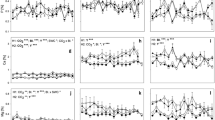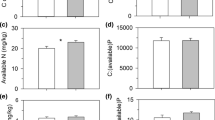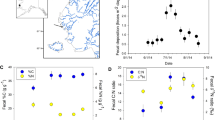Abstract
It is plausible that the nutritional quality of C3 plants will decline more under elevated atmospheric CO2 than will the nutritional quality of C4 plants, causing herbivorous insects to increase their feeding on C3 plants relative to C4 plants. We tested this hypothesis with a C3 and C4 grass and two caterpillar species with different diet breadths. Lolium multiflorum (C3) and Bouteloua curtipendula (C4) were grown in outdoor open top chambers at ambient (370 ppm) or elevated (740 ppm) CO2. Bioassays compared the performance and digestive efficiencies of Pseudaletia unipuncta (a grass-specialist noctuid) and Spodoptera frugiperda (a generalist noctuid). As expected, the nutritional quality of L. multiflorum changed to a greater extent than did that of B. curtipendula when grown in elevated CO2; levels of protein (considered growth limiting) declined in the C3 grass, while levels of carbohydrates (sugar, starch and fructan) increased. However, neither insect species increased its feeding rate on the C3 grass to compensate for its lower nutritional quality when grown in an elevated CO2 atmosphere. Consumption rates of P. unipuncta and S. frugiperda were higher on the C3 grass than the C4 grass, the opposite of the result expected for a compensatory response to the lower nutritional quality of the C4 grass. Although our results do not support the hypothesis that grass-specialist insects compensate for lower nutritional quality by increasing their consumption rates more than do generalist insects, the performance of the specialist was greater than that of the generalist on each grass species and at both CO2 levels. Mechanisms other than compensatory feeding, such as increased nutrient assimilation efficiency, appear to determine the relative performance of these herbivores. Our results also provide further evidence against the hypothesis that C4 grasses would be avoided by insect herbivores because a large fraction of their nutrients is unavailable to herbivores. Instead, our results are consistent with the hypothesis that C4 grasses are poorer host plants primarily because of their lower nutrient levels, higher fiber levels, and greater toughness.
Similar content being viewed by others

References
Arp WJ (1991) Effects of source-sink relations on photosynthetic acclimation to elevated CO2. Plant Cell Env 14:869–875
Barbehenn RV (1992) Digestion of uncrushed leaf tissues by leaf-snipping larval Lepidoptera. Oecologia 89:229–235
Barbehenn RV (1993) Silicon: an indigestible marker for measuring food consumption and utilization by insects. Entomol Exp Appl 67:247–251
Barbehenn RV (1995) Measurement of protein in whole plant samples with ninhydrin. J Sci Food Agric 69:353–359
Barbehenn RV, Bernays EA (1992) Relative nutritional quality of C3 and C4 grasses for a graminivorous lepidopteran, Paratrytone melane (Hesperiidae). Oecologia 92:97–103
Belovsky GE, Slade JB (2000) Insect herbivory accelerates nutrient cycling and increases plant production. Proc Natl Acad Sci USA 97:14412–14417
Bernays EA (1991) Evolution of insect morphology in relation to plants. Philos Trans R Soc Lond B 333:257–264
Bernays EA, Barbehenn RV (1987) Nutritional ecology of grass foliage-chewing insects. In: Slansky F Jr, Rodriguez JG (eds) Nutritional ecology of insects, mites, spiders and related invertebrates. Wiley, New York, pp 146–174
Bernays EA, Chapman RF (1976) Antifeedant properties of seedling grasses. Symp Biol Hung 16:41–46
Bernays EA, Chapman RF (1977) Deterrent chemicals as a basis of oligophagy in Locusta migratoria. Ecol Entomol 2:1–18
Bernays EA, Hamai J (1987) Head size and shape in relation to grass feeding in Acridoidea (Orthoptera). Int J Morphol Embryol 16:323–336
Bezemer TM, Jones TH (1998) Plant-insect herbivore interactions in elevated atmospheric CO2: quantitative analyses and guild effects. Oikos 82:212–222
Boutton TW, Cameron GN, Smith BN (1978) Insect herbivory on C3 and C4 grasses. Oecologia 36:21–32
Caswell H, Reed FC (1975) Indigestibility of C4 bundle sheath cells by the grasshopper Melanoplus confusus. Ann Entomol Soc Am 68:686–688
Caswell H, Reed FC (1976) Plant-herbivore interactions: the indigestibilty of C4 bundle sheath cells by grasshoppers. Oecologia 26:151–156
Caswell H, Reed F, Stephenson SN, Werner PA (1973) Photosynthetic pathways and selective herbivory: a hypothesis. Am Nat 107:465–480
Chang NT, Lynch RE, Slansky FA, Wiseman BR, Habeck DH (1987) Quantitative utilization of selected grasses by fall armyworm larvae. Entomol Exp Appl 45:29–35
Chatterton NJ, Harrison PA, Bennett JH, Asay KH (1989) Carbohydrate partitioning in 185 accessions of Gramineae grown under warm and cool temperatures. J Plant Physiol 134:169–179
Choong MF, Lucas PW, Ong JSY, Pereira B, Tan HTW, Turner IM (1992) Leaf fracture toughness and sclerophylly: their correlations and ecological implications. New Phytol 121:597–610
Clay K (1988) Fungal endophytes of grasses: a defensive mutualism between plants and fungi. Ecology 69:10-16
Clay K, Hardy TN, Hammond AM Jr (1985) Fungal endophytes of grasses and their effects on an insect herbivore. Oecologia 66:1–5
Coleman JS, Bazzaz FA (1992) Effects of CO2 and temperature on growth and resource use of co-occurring C3 and C4 annuals. Ecology 73:1244–1259
Coviella CE, Trumble JT (1999) Effects of elevated atmospheric carbon dioxide on insect-plant interactions. Conserv Biol 13:700–712
Crowell HH (1943) Feeding habits of the sourthern armyworm and rate of passage of food through its gut. Ann Entomol Soc Am 36:243–249
Dadd RH (1977) Qualitative requirements and utilization of nutrients: insects. In: Rechcigl M (ed) CRC Handbook in nutrition and food, nutritional requirements, vol 1. CRC, Cleveland, pp 305–346
Drake BG, Leadley PW, Arp WJ, Nassiry D, Curtis PS (1989) An open top chamber for field studies of elevated atmospheric CO2 concentration on saltmarsh vegetation. Funct Ecol 3:363–371
Drake BG, Gonzalez-Meler MA, Long SP (1997) More efficient plants: a consequence of rising atmospheric CO2? Annu Rev Plant Physiol Mol Biol 48:609–639
Farrar RR, Barbour JD, Kennedy GG (1989) Quantifying food consumption and growth in insects. Ann Entomol Soc Am 82:593–598
Feeny PP (1970) Seasonal changes in oak leaf tannins and nutrients as a cause of spring feeding by winter moth caterpillars. Ecology 51:565–581
Garland T, Adolph SC (1994) Why not to do two-species comparative studies: limitations on inferring adaptation. Physiol Zool 67:797–828
Gordon HT (1968) Quantitative aspects of insect nutrition. Am Zool 8:131–138
Goverde M, Erhardt A (2003) Effects of elevated CO2 on development and larval food-plant preference in the butterfly Coenonympha pamphilus (Lepidoptera, Satyridae). Global Change Biol 9: 74–83
Goverde M, Erhardt A, Niklaus PA (2002) In situ development of a satyrid butterfly on calcareous grassland exposed to elevated carbon dioxide. Ecology 83:1399–1411
Guppy JC (1961) Life-history and behaviour of the armyworm, Pseudaletia unipuncta (Haw.) (Lepidoptera: Noctuidae), in eastern Ontario. Can Entomol 93:1141–1153
Hättenschwiller S, Schafellner C (1999) Opposing effects of elevated CO2 and N deposition on Lymantria monacha larvae feeding on spruce trees. Oecologia 118:210–217
Harvey GT (1975) Nutritional studies of eastern spruce budworm (Lepidopera: Tortricidae) II. Starches. Can Entomol 107:717–728
Haukioja E (2003) Putting the insect into the birch-insect interaction. Oecologia 136:161–168
Hendrix DL (1993) Rapid extraction and analysis of nonstructural carbohydrates in plant tissues. Crop Sci 33:1306–1311
Hewitt GB, Onsager JA (1983) Control of grasshoppers on rangeland in the United States—a perspective. J Range Manage 36:202–207
Isely FB (1944) Correlation between mandibular morphology and food specificity in grasshoppers. Ann Entomol Soc Am 37:47–67
Johnson RH, Lincoln DE (1991) Sagebrush carbon allocation patterns and grasshopper nutrition: the influence of CO2 enrichment and soil mineral limitation. Oecologia 87:127–134
Karowe DN, Siemens DS, Mitchell-Olds T (1997) Species-specific response of glucosinolate content to elevated atmospheric CO2. J Chem Ecol 23:2569–2582
Lambers H (1993) Rising CO2, secondary plant metabolism, plant-herbivore interactions and litter decomposition. Theoretical considerations. Vegetatio 104(105):263–271
Landa K, Rabinowitz D (1983) Relative preference of Arphia sulphurea (Orthoptera: Acrididae) for sparse and common prairie grasses. Ecology 64:392–395
Latch GCM, Potter LR, Tyler BR (1987) Incidence of endophytes in seeds from collections of Lolium and Festuca species. Ann Appl Biol 111:59–64
Lincoln DE, Sionit N, Strain BR (1984) Growth and feeding response of Pseudoplusia includens (Lepidoptera: Noctuidae) to host plants grown in controlled carbon dioxide atmospheres. Envir Entomol 13:1527–1530
Lincoln DE, Couvet D, Sionit N (1986) Responses of an insect herbivore to host plants grown in carbon dioxide enriched atmospheres. Oecologia 69:556–560
Lincoln DE, Fajer ED, Johnson RH (1993) Plant-insect herbivore interactions in elevated CO2 environments. Trends Ecol Evol 8:64–68
Lindroth RL (1996) CO2-mediated changes in tree chemistry and tree-lepidopteran interactions. In: Koch GW, Mooney HA (eds) Carbon dioxide and terrestrial ecosystems. Academic Press, San Diego, pp 105–120
Lindroth RL, Arteel GE, Kinney KK (1995) Responses of three saturniid species to paper birch grown under enriched CO2 atmospheres. Funct Ecol 9:306–311
Marks S, Lincoln DE (1996) Antiherbivore defense mutualism under elevated carbon dioxide levels: a fungal endophyte and grass. Env Entomol 25:618–623
Martin MM, Van’t Hof HM (1988) The cause of reduced growth of Manduca sexta larvae on a low-water diet: increased metabolic processing costs or nutrient limitation? J Insect Physiol 34:515–525
Mattson WJ (1980) Herbivory in relation to plant nitrogen content. Annu Rev Ecol Syst 11:119–161
Nie G, Hendrix DL, Webber AN, Kimball BA, Long SP (1995) Increased accumulation of carbohydrates and decreased photosynthetic gene transcript levels in wheat grown at an elevated CO2 concentration in the field. Plant Physiol 108:975–983
Pollock CJ, Cairns AJ (1991) Fructan metabolism in grasses and cereals. Annu Rev Plant Physiol 42:77–101
Poorter H (1993) Interspecific variation in the growth response of plants to an elevated ambient CO2 concentration. Vegetatio 104/105:77–97
Poorter H, Roumet C, Campbell BD (1996) Interspecific variation in the growth responses of plants to elevated CO2 : a search for functional types. In: Korner C, Bazzaz FA (eds) Biological diversity in a CO2-rich world, physiological ecology series. Academic Press, San Diego, pp 375–412
Poorter H, van Berkel Y, Baxter R, den Hertog J, Dijkstra P, Gifford RM, Griffin KL, Roumet C, Roy J, Wong SC (1997) The effect of elevated CO2 on the chemical composition and construction costs of leaves of 27 C3 species. Plant Cell Environ 20:472–482
Raubenheimer D, Simpson SJ (1992) Analysis of covariance: an alternative to nutritional indices. Entomol Exp Appl 62:221–231
Saikkonen K, Faeth SH, Helander M, Sullivan TJ (1998) Fungal endophytes: a continuum of interactions with host plants. Annu Rev Ecol Syst 29:319–343
Saikkonen K, Helander M, Faeth SH, Schulthess F, Wilson D (1999) Endophyte-grass interactions: the case of Neotyphodium endophytes in Arizona fescue populations. Oecologia 121:411–420
SAS (2000) The SAS system for Windows, version 8e. SAS Institute, Cary, N.C.
Scheirs J, De Bruyn L, Verhagen R (2001) A test of the C3–C4 hypothesis with two grass miners. Ecology 82:410–421
Scriber JM, Feeny PP (1979) Growth of herbivorous caterpillars in relation to feeding specialization and to the growth form of their food plants. Ecology 60:829–850
Simpson SJ, Simpson CL (1990) The mechanisms of nutritional compensation by phytophagous insects. In: Bernays EA (ed) Insect-plant interactions, vol 2. CRC, Boca Raton, pp 111–160
Slansky F Jr, Scriber JM (1985) Food consumption and utilization. In: Kerkut GA, Gilbert LI (eds) Comprehensive insect physiology, biochemistry and pharmacology, vol 4. Pergamon, Oxford, pp 87–163
Traw MB, Lindroth RL, Bazzaz FA (1996) Decline in gypsy moth (Lymantria dispar) performance in an elevated CO2 atmosphere depends upon host plant. Oecologia 108:113–120
Tscharntke T, Greiler H-J (1995) Insect communities, grasses, and grasslands. Annu Rev Entomol 40:535–558
Van Soest PJ (1982) Nutritional ecology of the ruminant. O and B Books, Corvallis
Van Soest PJ, Robertson JB, Lewis BA (1991) Methods for dietary fiber, neutral detergent fiber, and nonstarch polysaccharides in relation to animal nutrition. J Dairy Sci 74:3583–3597
Van Zyl A, Van der Westhuizen MC, Van der Linde TC, De K (1998) Aspects of excretion of antlion larvae (Neuroptera: myrmeleontidae) [sic] during feeding and non-feeding periods. J Insect Physiol 44:1225–1231
Vicari M, Bazely DR (1993) Do grasses fight back? The case for antiherbivore defences. Trends Ecol Evol 8:137–141
Vincent JFV (1982) The mechanical design of grass. J Mater Sci 17:856–860
Vincent JFV (1991) Strength and fracture of grasses. J Mater Sci 26:1947–1950
Volenec JJ, Nelson CJ (1984) Carbohydrate metabolism in leaf meristems of tall fescue. Plant Physiol 74:590–594
Waldbauer GP (1968) The consumption and utilization of food by insects. Adv Insect Physiol 5:229–289
Wand SJE, Midgley GF, Jones MH, Curtis PS (1999) Responses of wild C4 and C3 grass (Poaceae) species to elevated atmospheric CO2 concentration: a meta-analytic test of current theories and perceptions. Global Change Biol 5:723–741
Wheeler GS, Slansky F (1991) Compensatory responses of the fall armyworm (Spodoptera frugiperda) when fed water- and cellulose-diluted diets. Physiol Entomol 16:361–374
White JF, Chambless DA (1991) Endophyte-host associations in forage grasses. XV. Clustering of stromata-bearing individuals of Agrostis hiemalis infected by Epichloe typhina. Am J Bot 78:527–533
Wilkinson L (2000) SYSTAT: the system for statistics. SYSTAT, Evanston
Williams RE, Allred BW, DeNio RM, Paulsen HE Jr (1968) Conservation, development, and use of the world’s rangelands. J Range Manage 21:355–360
Wilsey BJ, Coleman JS, McNaughton SJ (1997) Effects of elevated CO2 on grasses: a comparative ecosystem approach. Ecol Appl 7:844–853
Acknowledgements
We thank Michael M. Martin for suggesting substantial improvements to the manuscript, Rick Lindroth, Steve Kohler, and Ken Guire for statistical consultation, Ping Wang and Ron Myers for providing eggs, Dan Johnston for providing L. multiflorum seed, Don Hendrix for advice on carbohydrate analysis, N. Jerry Chatterton for providing purified fructan standards, and James Teeri for logistical support at UMBS. This work was supported by USDA grant 99-35302-8050 to R.V.B. and D.N.K.
Author information
Authors and Affiliations
Corresponding author
Rights and permissions
About this article
Cite this article
Barbehenn, R.V., Karowe, D.N. & Spickard, A. Effects of elevated atmospheric CO2 on the nutritional ecology of C3 and C4 grass-feeding caterpillars. Oecologia 140, 86–95 (2004). https://doi.org/10.1007/s00442-004-1572-9
Received:
Accepted:
Published:
Issue Date:
DOI: https://doi.org/10.1007/s00442-004-1572-9



